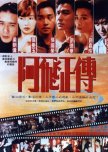
"You'll see me in your dreams tonight"
Days of Being Wild showed what lengths broken people would go to in order find the object of their desire. Time, whether it hastened by too quickly or dragged like a cement block, tethered the characters to their obsessions. Everyone had a myopic gaze of life and much of it revolved around a self-obsessed rebel.Yuddy had a habit of seducing women and then breaking their hearts. Raised by a sex worker, he desperately wanted to know who his biological mother was. Rebecca had told him his mother was a Filipino noblewoman who had paid her to raise him. Mom really put a lot of thought into that one, didn’t she? Yuddy seduced Su Li Zhen who ran a snack stand and box office by having her look at his watch for a minute. One minute before 3:00 was to be burned in their minds on that date. Their relationship flared and flamed out when Li Zhen realized he would never marry her. Before he could change the sheets on his bed, he’d seduced exotic dancer Mimi.
Women were obsessed with Yuddy---Li Zhen, Mimi, and even his adoptive mother Rebecca. And I never could figure out why. He thought only about himself and constantly told them what they could and couldn’t say. He must have been one hell of a lover to make them lose their dignity and hearts over him. Young love is often messy and impulsive with heavy doses of heartache and drama but it was hard to understand why these women found him so irresistible. How desperate for love, sex, and/or companionship they must have been. Loneliness can be a harsh mistress.
Yuddy often compared himself to a bird with no legs who had to keep flying when in reality the bird had been dead all along. The story lost steam when he left Hong Kong to find his mother in the Philippines. Without the women he seemed even more like a loser with no job, no family, and on a headlong journey to disaster.
Much of the background noise was the chiming and ticking of clocks. “I used to think a minute could pass so quickly, but actually, it can take forever,” Li Zhen told the young policeman named Tide. Later Yuddy would tell Tide, “Life really isn’t that long.” For the heartbroken, the nights took forever to pass. For a young man who made a reckless decision, it passed all too quickly and that minute would be seared in his memory.
The cast was stellar. Leslie Cheung gave Yuddy a primal movement that even the corny pickup line of, “You’ll see me in your dreams tonight” made women thirsty for him. Maggie was gorgeous but other than standing or walking around looking anguished with her hair in her eyes had little to do. Carina Lau as Mimi chewed up the scenery as the brash cabaret dancer in love with Yuddy. Andy Lau, like Maggie, was underused until the final chapter. The dark, subdued lighting and greens and golds were reminiscent of In the Mood for Love, as well as the final character revealed.
Perhaps because the actors seemed too old to be so foolhardy, I found the characters difficult to connect with and care about. The despondent mood was as dreary as the rain soaked streets the characters wandered through. Days of Being Wild was beautifully shot, lit, and composed and while mesmerizing to look at, it left me feeling empty afterward.
28 February 2024
Was this review helpful to you?

"Not yet!"
At 83, director Kurosawa Akira showed his creative drive was still going strong. However, he didn’t get his wish to die on set behind the camera on this his final film. What he did, was give us a film with a main lead who in many ways stood in for him and his desires and contemplative messages. The film might have been loosely based on Uchida Hyakken’s novel but it felt like watching Kurosawa take his final bow.In 1943 Professor Uchida greets his class and tells them that he is resigning in order to write full-time. His students are devoted to him and tell him they will continue to follow him. They help the professor when he and his wife move into a larger home which later ends up catching fire in an air raid. The couple is relegated to a small shack with a few meager possessions afterwards. The students begin work on a plan to have a better home built for the professor. To boost the professor’s morale when he regrets living the life of a beggar, they hold a birthday party for him called the Not Yet Feast on his 61st birthday. The play on words comes from the game hide and seek when children would yell, “are you ready?” and the response would often be “not yet!” or madadayo. Though provisions were few, the students and professor had a raucous time at the celebration. “Are you ready to die?” “Not yet!”
“Did that just go over their heads?”
Kurosawa’s work came across as uncharacteristically hopeful in this film. The professor was described as pure gold. Eccentric, imaginative, and a prankster, the students loved him. The students were unequivocally kind and devoted to him. Whereas most Kurosawa leads had to face grueling trials in order to have character development, the Professor came fully and nearly perfectly formed. The pessimistic and deeply flawed people were missing as well as the tumultuous inner struggles. Even the students whose names were barely mentioned were deeply kind and loyal. Unlike earlier films with biting social commentary, the historical events in Madadayo were a thin construct that had minimal impact on the characters. The hardships were briefly alluded to and overcome, unlike Kurosawa’s usual criticisms surrounding the war and post war struggles. It was if Kurosawa said, “I’ve already covered that.”
“Congratulations should be short. Eulogies should be long.”
In each of his dwellings, the Professor sat in his doorway and wrote. There were no battles or betrayals, the most tragic event in the film was when a cat went missing. This film focused on the Professor’s interior musings and the interiors of his homes and the banquet halls where the Not Yet Feasts were held. Despite his insistence on an almost hermit-like existence with signs that ranged from “The temple where guests are forbidden” to roughly translated, “Whaddya want?” the Professor was nearly always surrounded by adoring students. When the Professor needed a house, the students made it happen. When the Professor’s cat went missing, they beat the bushes to find the friendly feline. In most Kurosawa films, everyone needed to watch their backs. In Madadayo, it was the nice being nice to the nice, injected with gentle humor and wisdom.
“The flowing river never stops and the water is never the same as before. The bubbles that float in the pools, now vanishing, now forming are not of long duration.”
After I recovered from the shock of realizing that everyone in the film was affectionate and generous to each other, I settled in and enjoyed the story. Kurosawa’s film style veered closer to Ozu’s than his own. Few scenes had his three deep perspective with action going on in the foreground, middle, and background. People were often sitting in a circle on the floor talking. There was a beautifully shot seasonal montage with the small shack going through fall, winter, and spring. The characters could have used improvement. The students’ personalities were never developed and the background wife never received a name. The cat even had a name, but not the wife! No mention was made of what the German language professor wrote that was so popular.
“That will be your calling, the work you put your heart into.”
What Madadayo did give us was different generations respecting and caring for each other. Kurosawa and Uchida were both facing death unflinchingly. This was not the time for fighting, but a time of introspection and peace while also contemplating the legacy of their work. The Professor encouraged the grandchildren of his students to find their treasure and to work hard for it, much as Kurosawa had.
Despite the utter lack of conflict, I enjoyed Madadayo. Every once in a while, I need a film that envelopes me in warmth and laughter. Perhaps that’s what Kurosawa needed as well. I was pleased when I saw Kurosawa’s red glow in the last scene and beautiful, tranquil clouds appeared. Then my eyes welled with tears when I realized it would be the last time for those trademark elements. If someone had asked Kurosawa if he was ready to stop creating or studying film, I think his answer would have been, “Not yet!”
26 February 2024
Was this review helpful to you?

"What does flunked mean?"
I Flunked, But… was one of Ozu’s early silent films about university life. It was a warmhearted story demonstrating life’s ups and downs during and after university.Shomochi and his four buddies don’t take things too seriously as they cheat during exams and spend the evening before the big final exam cramming. Shomochi is the leader helping the others to study. He also prepares his white shirt as an answer guide. Nothing is ever that easy, especially when the house mom inadvertently collects the cheat sheet shirt along with the dirty clothes and gives it to the laundry services. The roommates panic at the loss. Much to everyone’s surprise the four roommates pass while Shomochi fails. The boys are sad for their friend, but Shomochi is devastated to not be able to graduate. Shomochi receives comfort from an unexpected source and finds his path toward adulthood and confidence. The four graduates discover the harsh reality of a disastrous economy where their diplomas mean very little.
Just as bachelor Ozu made numerous films about marriage and family life, he never attended university, so his take on it was more what he envisioned it to be than what he’d experienced. I enjoy Ozu's silent films, his style was more mobile. People moved naturally and looked at each other, not the camera, when they were talking. He wasn't rigid with filming from the mat and some shots were filmed from a higher position. The comedy felt organic and not forced. The boys had many humorous moments without delving completely into slapstick. I did miss his meticulously designed sets with the spare compositions. Of course, these were college boys and cluttered rooms were more realistic. An American movie poster and American university pennants decorated the walls. Ozu's teapot did receive prominent placement in one shot!
While there were many comedic moments, they alternated with sadness and discouragement. University life felt more insular. When the graduates faced the unforgiving economy, they were the ones needing help and encouragement. “Why did we have to graduate so fast?” Shomochi, on the other hand, moved toward maturity and finding joy in the moment.
This film shared the bonds formed from late night study sessions and walking arm and arm to a dance beat. Love brought encouragement in the darkest moments as did friendship. Maturity became a path adversity set them on. I Flunked, But… asked what it means to fail, and if one fails…what next? What happens when you do everything right but still can’t succeed? Ozu left some of those questions unanswered for the students who sought to find happiness amidst the sorrow and victory from failure.
25 February 2024
Was this review helpful to you?
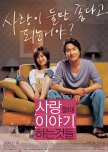
Sometime love ain't enough, and sometimes it is
Solace is a difficult movie to pigeonhole. While it is a romance, the leads spend large amounts of time apart. The pacing is slow like a slice of life and there are troubles enough for a melodrama. The leads involved occasionally find solace with each other, a gentle spot far removed from their daily grueling challenges.Somehow Lee Hye Ran has inherited her deceased father’s massive debt. I don’t understand Korean law and how it ended up with her and not her mom. Be that as it may, Hye Ran is drowning in debt and hounded by her father’s creditors. She runs a clothing shop where she often sells counterfeit clothing. Her sister is pregnant and getting married, adding to her financial concerns. Meanwhile, In Ku is a pharmacist living with his mother and mentally impaired brother, In Seob. His marriage plans fell through when the bride’s family forbade them to marry because of the brother’s condition. Neither Hye Ran nor In Ku are looking for love but fate insisted on throwing them together on several occasions. The two find comfort in each other’s company and arms, but regardless of their feelings, Hye Ran’s debt doesn't disappear and In Seob’s needs don't lessen.
Solace was a realistic look at two people for whom life could be a difficult grind. Realistically, love didn’t conquer all and solve all their problems. The film wasn’t all dreary and pessimistic. Both people were reminded of what they were missing. It instilled in them a desire to find joy in their lives whether it was listening to a familiar song or taking a hike. Speaking of music, it was a blast from another past to see a Walkman and a car with a cassette player in it. Both Hye Ran and In Ku had responsibilities they could not be released from. Opening their hearts to each other, helped them to open them to others. Sometimes love can be expressed in a myriad of ways, Solace explored love in different relationships, the joy it can bring, and the loving sacrifices people make for each other. While not a traditional romance, it was a film that stayed true to itself.
24 February 2024
Was this review helpful to you?
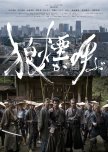
An heirloom's hidden past...
Wolf’s Calling is a stylish short film by director Toyoda Toshiaki with no dialogue. It is truly a mood piece bordering on samurai music video. This is the first film in his Resurrection trilogy followed by The Day of Destruction.A young woman discovers a rusty revolver in a box and takes it out. The memories imbued in the cold steel open up for the audience. Several samurai gather at the Mountain Resurrection Temple-Wolf. Soldiers in blue uniforms join them shouting, the only human sounds in the film. A woman’s sash and hairpin are laid out by one samurai and another carries a child’s toy implying the reasons for their solemn assembly. They silently form ranks with knowing glances. Drums echo the sounds of the approaching enemy. Weapons are drawn as well as the revolver.
An impressive cast lent weight to the performances making me wish this had been a full-length film. While the samurai might have been avenging loved ones, the real inspiration for the film had more to do with Toyoda’s arrest for possessing an illegal firearm, cleared up when it was shown that it was a family heirloom dating back to WWII. Like him, when looking at family heirlooms I wonder about the stories and people behind them.
Though Wolf’s Calling was a short film, the shots of the warriors walking through the old growth forest to the temple were resplendent. The temple was used in this film and The Day of Destruction, I have yet to watch the third film. The Young American revolver style was first made in 1905 which if they did their homework would help to date the action in the past. The music filled in for the dialogue conveying the urgency and determination of the men involved. The body language of the actors also conveyed their deadly resolve.
The film is so short that I watched it twice, enjoying it more the second time. The acting, scenery, and music gave the glimpse into the family’s past a depth that in lesser hands would have fallen flat. After watching Wolf’s Calling and The Day of Destruction which were both low budget films, I’m looking forward to trying more of his work. If you’ve never watched a silent film this might be a good gateway film.
23 February 2024
Was this review helpful to you?

"Now is the time to rage. If not now, when?"
In 2020 director Toyoda was angry. Very angry. Angry about the pandemic. Angry about the wealthy and politicians. Angry about the Olympics. And especially angry about apathy toward the hell many people were living in. The Day of Destruction fiercely and poetically screamed that rage out.“Draw your sword now. If not it ain’t rock ‘n' roll.”
Seven years ago, a pulsating globular monster appeared deep in a mine. Since then, a plague of some sort had spread. In 2020 after the epidemic took the life of Kenichi’s sister, he attempted to self-mummify at the Mountain Resurrection-Wolf temple (the same one used in Wolf's Calling) believing his sacrifice would quell the epidemic.
“What defines a human. Prove it now.”
An earthquake set loose Kenichi’s inner rage which turned him into a demon.
“Humans possessed by demons are exorcised by humans, but maybe the exorcists themselves are demons”
Priest Jiro believed that destroying the monster was a fool’s task. Nature gave them the epidemic so the monster must be led onto the right path. Kenichi must be guided onto the right path as well.
“Price tags on lives fluttering in the wind”
The wealthy and elite hid in their fortresses, safe from human misery all while planning on how to make money during the event of the year-the 2020 Olympics.
“Give me your anger. I’ll respect it.” “We have a voice. Your own voice. SHOUT!”
The people cried out their pain and fears. A bloody, red Kenichi fell down on his knees in traffic screaming his grief and outrage.
“Everyone on Earth is a central prayer…We’re all in the same boat called Generation.”
Humans are the problem. Humans are the solution. The division after division after division must be faced. Would prayer or self-sacrifice cause others to change or would the first step be the hardest? Changing oneself. Eradicating the monster might not be possible---healing, and coexisting might be.
“Would self-restraint for 100 years be enough?”
Shot on a small budget in eight days, Toyoda got the most out of the beautiful mountain scenery and the actors. I have to wonder if he received permission for the shots in the streets as ordinary masked passersbys walked around Kenichi as if a man in bloody red clothes shrieking and kneeling in the crosswalk was completely normal. The music and sound effects were not always pleasing but they were fascinating and told much of the story as there was little dialogue.
“Hey, Siri. How much longer do I have to put up with this?”
If we live in hell with demons and people acting like demons, maybe the screaming is necessary to wake ourselves up. Shake off the apathy and change. The Day of Destruction with its loud music and release of pent up fury might have been what we all needed, especially during the first year of the pandemic with people struggling in so many ways and losing people to an invisible monster. This film won’t be for everyone to be sure. It's abstract with lots of religious symbolism and can be confusing at times. For the most part, I enjoyed its poetic and manic response to a nightmare much of the world shared.
23 February 2024
Was this review helpful to you?

"Someone went ahead of you again"
Lola Igna showed that a long life isn’t always a gift when a person has to watch as her family and friends all leave her behind. Veteran Filipino actress Angie Ferro portrayed the 118-year-old Igna who was in the running for oldest grandmother in the world. Lola Igna was a message of resiliency, quiet resignation, and reconciliation shown through the life of one woman and her tattered family.Lola Igna’s great-granddaughter Nida takes the older woman to the mayor’s office where she is to receive an award for being the oldest grandmother in the Philippines. When asked what she hasn’t done that she would like to do by reporters, she tells them what she is looking forward to is death. While researching her age, the group Amazing People of the World believes she might be the oldest grandmother in the world which would come with a substantial cash prize. Nida is thrilled with this news and immediately seeks to cash in on Lola Igna’s newfound fame. On one of the tours to Igna’s house in the rice fields, her long lost great-great grandson arrives and makes his way into her life.
Director Roy depicted Lola Igna’s sparse surroundings without sliding into poverty porn. The flies, chamber pot, and simple meals didn’t come across as denigrating. Angie Ferro played Igna with dignity and a sense of humor while also hiding her sorrow at having lost family, friends, and even the man who was the first baby she ever delivered as a midwife. After some coconut wine her loneliness and her anger at God for leaving behind a person willing and ready to join her departed husband while younger people died spewed out. Yves Flores as Tim bounced into her world with his cell phone and camera and a healthy dose of respect for his great-great grandmother. He was also a reminder to everyone of his mother who left years before and never returned.
Lola Igna was a glimpse into the heartache people feel when they’ve attended too many wakes. The last sibling, the last child, the one who outlived those who were born after her was a terrible burden. Death is part of life, and Igna was ready to join her beloved unafraid of what lie ahead. While her final destination was delayed, Igna also gave freely of herself to her family and community. There were those who benefited financially from the centenarian yet the movie overwhelming showed the community’s and family’s loving generosity which led to heartfelt reconciliations. No life is free from sorrow but Lola Igna showed that it could be faced with grace and when necessary, a full chamber pot.
22 February 2024
Was this review helpful to you?
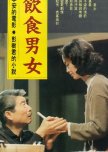
"Eat, drink, man, woman, food and sex-basic human desires"
Eat Drink Man Woman is a film by Ang Lee that I’ve watched before and wanted to revisit. I liked it even better this time than I did the first, maybe it is an acquired taste. Food, family, love, loss, and secrets made for a tasty feast to sit down to.Mr. Chu is a widowed chef who has lost his sense of taste. He has three daughters who live with him. Each lives their lives separately except for when they sit down to the elaborate Sunday meals he prepares. One by one they face challenges, and find new love or new paths to take.
The food preparation was sumptuous. Chicken, pork, fish, a variety of seafood, hot pot, all made not only to taste with the mouth but with the eyes as well. No one would have to cook for a week with the Sunday dinners the father served. The daughters didn’t eat that much and there were enormous quantities of food leftover. Much of the food was also shared with the eldest daughter’s divorced friend and child. Mr. Chu would also pack culinary delights for the child to take to school for her lunches making her very popular with her classmates. The middle daughter loved to cook like her father, but had been banished from the restaurant kitchen so that she would find a proper job. While she excelled at her position with an airline, her passion was making the dishes she’d seen her father so thoughtfully prepare.
Everyone cared about the other yet had lost the capacity to communicate freely. Only when things began to be shaken up and the status quo was flipped over and scattered did father and daughters begin to reach out again. Sometimes a pot can be simmering quietly on the stove and is only noticed when it boils over. The dish isn’t ruined if someone attends to it lovingly. Everyone in the Chu family had to discover what made them happy, what helped them be who they wanted to be. Sometimes that exploration led to loss before it led to gain. If you enjoy watching elaborate meals being prepared as well as father-daughter, and sisterly relationships being explored, this quirky family drama is seasoned to near perfection.
21 February 2024
Was this review helpful to you?

"Keep your enemies closer"
Knight Flower was a funny, entertaining cross between a female Robin Hood and Zorro. The story may not have had any surprises, but in this genre as in most. execution is key and Knight Flower kept the action moving and the long boring monologues by the villains to a minimum.Yeo Hwa never even met her husband who was killed on the way to the wedding and has been a cloistered widow for 15 long years. Stuck in the family shrine most days, never being able to set foot outside of her in-laws’ property she only has her maid Yeon Seon for company as she waits on her older brother to finally return and take her with him. What no one in the household knows except for Seon is that at night Yeo Hwa dresses in black and helps the helpless with her money and martial arts. Everything is going smoothly until she runs into the new Capital Defense officer, Park Su Ho. With lots of push and pull between the upright lawman and the vigilante, as well as the requisite romantic tension, the two find they have much in common as well as common enemies.
The first episode felt slow to me, but it picked up the pace as it went along and never slowed down again until the last episode. Given the prison-like existence of the widows and pressure to commit suicide for the family honor, it was a whimsical release to have the heroine running over rooftops and rescuing the male lead on occasion. Of course, only women were held to these standards. Widowers were free to go about and even encouraged to remarry. Repression reconfigured to look like honor.
I enjoyed the story, but stumbled some with the casting, or perhaps the writing. Full disclosure, I enjoy a good noona romance so that wasn't an issue . Nor do I have a problem with an older woman being an action hero, much older men do it all the time. Lee Ha Nee is a beautiful woman but at 40 she did not look 32 nor very athletic. Her character was someone skilled with living a double life for years, but Yeo Hwa could not manage a poker face when needed. Yeo Hwa was quick to act but often slow to catch on to the bad guys’ plans. Lee Jong Won looked like a sweet puppy who adored Yeo Hwa, but added little depth to his character. A quick glance at the cast list and it was easy to pick out who the baddies were going to be. When one used his kind grandpa voice instead of putting a character at ease, chills should have been running down their back. And Jo Jae Yoon can always be counted on to chew up the scenery maniacally.
Knight Flower, aside from bringing up the appalling way widows were treated, was for the most part a romantic action comedy. While there were some fights, they weren’t bloody or deadly. Most of the deaths occurred 15 years prior to the current story. The one murder in the present story actually felt quite deserved. So, if you like your historical dramas light and funny, with a little romance and a little action, this might be a good fit.
21 February 2024
Was this review helpful to you?
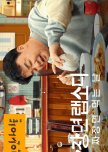
Grab a snack because this show will make you hungry!
Chinese Korean Food might have been a more accurate title than Jjajangmyeon Rhapsody. The two-episode food show with Baek Jong Won not only talked about the spicy black bean noodle dish but also other foods brought over with Chinese immigrants and adapted to Korean tastes.The first episode focused on Jjajangmyeon-how it evolved and became one of the most popular dishes in Korea. A celebratory dish at first, it’s now delivered to pool halls, offices, farm fields, and even boats. Six million bowls of the gooey black delight are sold in Korea every day. If the noodles were lined up end to end they would circle the globe 1 ½ times daily. Originally, a cheap food Chinese laborers cooked it slowly turned into the dish it is today. Chinese “places” as they were called in the 1960’s after a law was passed preventing the Chinese from buying real estate and businesses were quite popular and about the only foreign food available. When the economy accelerated in the 1980’s, Chinese restaurants took advantage of delivery service to expand their clientele.
Baek and other guests showed tips on how to enhance the eating experience. The main rule was to not be embarrassed about your face getting messy from the dark sauce. Different varieties and techniques were explored as well as how to spot an authentic Chinese restaurant. Brief historical moments that influenced where the Chinese settled were also thrown in.
Episode 2 covered Jjamppong. Apparently, one of the great dilemmas in a Chinese restaurant is whether to order Jjajangmyeon or Jjamppong. The evolution of Jjamppong from a mild dish to the torridly hot, “adult” dish was explored. Jjajangmyeon has relatively fewer variations whereas Jjamppong has endless varieties. Foodies take Jjamppong food tours, and new takes on the popular dish and hangover cure are created all the time. Two men have tried 500 Jjamppong places in eight years!
Episode 2 also covered Yaki Udon, Mandu (Korean dumplings), Tangsuyuk (Sweet and sour) and fried rice. Some Chinese immigrants came voluntary, others were voluntold by the Japanese when they occupied the peninsula and needed more laborers at the ports to load up the Korean rice on ships bound for Japan and its army. After the Korean war, Americans shipped large amounts of wheat to Korea which they put to good use in making tasty noodles.
I wish they’d given more credit to the hard-working Chinese immigrants who faced discrimination personally and legally and found a way to succeed. Just as they did in the United States, the Chinese often began restaurants and adapted their food for their new home. The documentary made it seem as if the Koreans’ tastes caused the dishes to be delicious instead of the originators of the food working to make them more palatable for their customers.
I enjoyed watching how different chefs created variations of Jjajangmyeon and Jjamppong, pouring their love and creativity into the popular noodle meals. Jjajangmyeon is a dish that brings happiness as well as satiation and that joy was infectious. If you enjoy food shows, this is one to give a try. Just don’t forget to have a snack nearby.
18 February 2024
Was this review helpful to you?

A valuable piece of film history
I love that for around 3 minutes in time I could step back into 1899 Japan and have a brief glimpse into the early film world. Momijigari was more of a documentary of two great Kabuki actors near the end of their lives in brief scenes from a famous play. It was still worth watching and surprisingly entertaining.Danjuro played the princess who was actually a demon in disguise. He gracefully danced with his fans, a challenge with the wind blowing as they filmed it outdoors. At one point, one of the fans blew out of his hand, rescued by the stagehand. Kikugoro played Taira no Koremori who valiantly fought the now ugly demon with long flowing hair. The demon used a maple branch against Taira’s katana. I was particularly impressed with Danjuro’s hair fighting skills. The fight was compressed in a small area with the costumed stagehand picking up debris as the two took part in their fighting choreography.
Though filmed in 1899, it wasn’t shown in public until 1903 when Danjuro was too ill to take the stage and gave his permission. Kikugoro had already died at that time making it even more popular for people to see. It was then shown again after Danjuro’s death later that year. Though Danjuro was reluctant about having their performance filmed, the two actors’ legacies have been kept alive through these 3 minutes and 50 seconds worth of grainy film one hundred and twenty-five years later.
If you enjoy old films and film history, this is definitely worth less than five minutes of your time.
19 February 2024
Was this review helpful to you?

"Your attitude determines whether you are poison or antidote"
Outrage Coda brought Beat Takeshi’s Outrage trilogy to a fitting finale. Old school yakuza Otomo had been through a lot in the last two films, but he wasn’t through with the Sanno and Hanabishi families. If they’d left him alone, he might have been willing to let bygones be bygones. Too bad the younger yakuza weren’t smart enough to respect their elders, especially when their elder was a no-nonsense killing machine.After the incidents at the end of the previous film, Otomo took powerful fixer Chang up on a job offer and became the boss of his Jeju Island casinos and hotels in South Korea. Otomo and his underling Ichikawa spent their afternoons fishing and hanging out, that is until a Hanabishi yakuza named Hanada showed up. The cocky gangster had unusual sexual proclivities and hurt two of Otomo’s prostitutes, disrespected him, and killed one of his men. The Hanabishi family’s new head was a businessman who mishandled the whole affair with Otomo’s boss, Chang. Nomura, the new boss, was a businessman who’d never been to prison and had no tattoos and lacked the respect of the older executives. He attempted to have Chang murdered as well as ordering Nakata to murder his sworn brother, Nishino. Otomo never needed much of an excuse to go on a murderous rampage and rampage he did, taking revenge on anyone left who wronged him in the last two films and the current one. He made the Valentine’s Day Massacre look like a Sunday school picnic. Retribution thy name is Otomo or “F*ck Off”, whichever you prefer.
The original movie was wall to wall betrayals, torture sessions, and gruesome murders. The second film took the time to develop relationships and explain the treacherous maneuvering. This last film focused on the old guard having had enough of the lack of respect for the code by the younger upstarts. Much of this film focused on Nakata and Nishino’s strategizing in order to stay alive and remove obstacles to their power. This time instead of being everyone’s pawn, Otomo made his list, checked it twice and erased anyone on it. Despite the high body count, it felt lighter in tone than the others. Coda had more humor than the previous two, dark as it was.
Otomo kept to the code until the very end, showing he was a badass who never blinked in the face of death. He and the Habanishi brothers demonstrated why you’d best not underestimate old guys, there’s a reason they were still around in a job where most employees were given the early retirement plan paid out in lead. Outrage Coda wrapped up the trilogy in the only way a yakuza film could be, in blood.
17 February 2024
Was this review helpful to you?

"You know you are dealing with the yukuza, right?"
Outrage began the trilogy focusing on director Beat Takeshi’s traditional yakuza Otomo. The film could become wearisome as betrayal after betrayal ended in gruesome deaths for those up and down the yakuza ladder of power.The film’s plot could be hard to follow, or at least all of the players, as the Sanno family chairman started maneuvering all of his family’s subfamilies and tributaries, not realizing he was being played as well. The Murase family is in the chairman’s sights and soon the murders and torture scenes are ongoing. Even the ambassador from Ghana is dragged into their schemes. Dental equipment, a giant snake, chopsticks, knives, guns, and bombs. No one is safe as brother turns against brother, and even girlfriends are hunted down. There truly is no honor among thieves. Or among the police. Tokyo’s finest looked the other way and counted the money in their envelopes as the bodies started dropping.
My biggest problem with Outrage was that there was no one to feel sympathy for, as twisted as that sounds when watching a gangster movie. Everyone could have died a gory death, and many did, but it really meant nothing. They were all killers looking to make a buck and gain more power. Otomo had the old yakuza honor thing going for him, but he was just a deadly pawn easily used because he followed orders without asking questions for much of the movie.
Outrage had moments that were entertaining and the big plot reveal at the end helped to explain some of the mayhem. Character development of a few key figures would have helped enormously. Otherwise, it just felt like random people getting chopsticks jammed in their ears or eating bullets for lunch. In the end, killers killed killers who killed killers who killed killers…
17 February 2024
Was this review helpful to you?

"What are you packing? A toy gun?"
Outrage Beyond is the second in the Outrage trilogy featuring director Beat Takeshi as the ominous yakuza Otomo. In this installment Detective Kataoka is called in to use his connections with the different families to diffuse the Sanno family’s power after they assassinate a police officer.When the Sanno family kills a cop and begins pulling the strings of different politicians, Detective Kataoka goes to work whispering into the ears of disgruntled executives in the Sanno family. The new Sanno head has been ignoring the seniority system and pinching pennies while filling his own coffers. The rival Hanabishi family is reluctant to start a war even with the rumor that Kato killed his previous boss in order to be promoted. Kataoka pulls out his hidden ace when he has former yakuza boss, Otomo, paroled early from prison. So far everyone had been fairly civil in their expensive suits, but made the mistake of going on the offensive with Otomo. It’s all fun and games until someone pulls out the power tools for a good old fashioned gang interrogation.
This film was more about chess moves than gang violence. Like politics, yakuza alliances make strange bed fellows. Both friends and enemies alike betrayed each other. That’s not to say in the final third of the movie that the bodies didn’t start piling up, because they did. As the families went to war, the police sat back and watched. The acting was fairly average for a crime film. Kohinata Fumiyo made for a smarmy and conniving cop who was a little too close to the families. Matsushige Yutaka, Midnight Diner’s hot dog loving yakuza, played the straight laced cop appalled by Kataoka’s deadly methods. Beat Takeshi gave Otomo a world weariness for the yakuza with principles and who was also handy with a power drill. The plot while predictable was interesting though it did tend to drag when the negotiations and puffed chest scenes went on too long.
Outrage Beyond brought plenty of double-crosses, satisfying comeuppances, and even finger mutilation. The big moral of the story is if you want to keep your job as the head of the family, don’t cheap out and not provide a meal for your officers, a well fed exec is a less deadly exec. If you enjoy gangster movies and don’t mind more talking than usual in your crime families, Outrage Beyond is one to give a try.
16 February 2024
Was this review helpful to you?
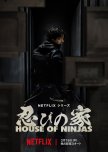
The family that slays together stays together!
House of Ninjas was an entertaining mix of action, humor, and conspiracies with a little romance thrown in for good measure. Three generations living in the same house can be a source of stress on any family, especially for one that has a dark secret.After a mishap on a mission six years before, a family of ninjas may live in the same house, but they are all going in their own direction. Dad Soichi runs the failing family sake brewery and wants his family to lead a normal life. Mom Yoko is a bored stay at home mom and shoplifts in her spare time. Daughter Nagi is frustrated and puts her own spin on theft. Like his dad, son Haru wants a normal life and spends his nights refilling vending machines and having dinner in the same place so that he can be near the young woman who has her daily meal there. Retired Grandma Ninja keeps an eye on everyone, especially the youngest, Riku. The ninja code puts a crimp in Haru's love life when he is reminded that he’s not allowed to date just anyone, especially a comely reporter. When a rival ninja family reappears, the family will have to pull together to help save the nation.
House of Ninjas had a good balance of humor, romance, and bloody fight scenes. The ninja battles were entertaining and well choreographed if you don’t look too closely. The grannie-on-grannie ninja action was a hoot. The characters could make some inexplicably poor decisions at times. Apparently, ninja families are bad at interpersonal communication. When the going got tough, the family did pull together and have each others’ backs-literally. Each of the actors portrayed their characters well, glum Haru, mischievous Nagi, inquisitive Riku, and two parents who got their groove back. Throw in a deranged cult leader who thought he was god and you have everything you need for a fun ninja, excuse me, shinobi ride.
If you’re looking for a completely serious and blood-soaked drama, this isn’t it. If you are looking for a funny satire of ninjas, this isn’t it. If you are looking for a full-blown romance, this isn’t it. If you are looking for a ninja drama with high stakes, some light and dark humor, family drama exasperated by the ninja code, and a nice little romance, this could be worth a try. I found it compelling and entertaining, with some flaws.
15 February 2024
Was this review helpful to you?

 31
31 98
98 7
7





















